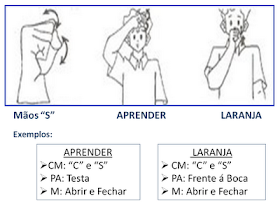Multimodal Literacies MOOC’s Updates
Update #5 A pedagogical practice that locates linguistic and gestural meanings in the context
At the end of the 12.6 Chapter, about the Grammar of gestural Meanings, Cope explains about sign languages, and how they prove that there is nothing in human meaning that we can not make in all the modes.
This reminded me about my classes of Libras (Língua de Sinais Brasileira), the second oficial language in Brazil that is a sign language, in the United States of America, there is ASL – American sign Language, in France there is the LSF – Langue de signes française and so on.Of course that in times of Covid-19, our face-to-face classes were suspended and we have now online classes.
The sign language has the same structure as a written language has, grammar, functions and its own singularities.
If we apply the Multiliteracies Grammar to gestural meanings, even knowing that sign languages do not have gestures, but their own signs, we can transfer the specificities (to refer, to dialogue, to structure, to situate, to intend) to the sign language.
However, the thing that most caught up my attention is the synesthesia – the metaphorical power – that we can analyze in sign languages. In this case, the modes that are being swifted constantly are not words and actions, but signs and meanings, when we use the sign to point out, we might be actually pointing something out to the person we are signaling/talking to, or we can be sigaling/talking about something completely different.
Sign languages are complex and they have their own structures to formulate sentences. In Libras, we have five parametres we need to pay attention and dominate, if we want to sign/speak fluently. The five parameters are: hand configuration, pivot point, movement, orientation and non-manual (or facial) expressions.
[OS CINCO PARÂMETROS: | Libra, Libra linguagem, Linguagem de sinais]
They are so intricated that if you do a sign with the hand configuration wrong, or in a wrong pivot point, you can mess up the meaning of the whole sentence.
For example, the sign in Libras for learn and orange have the same hand configuration and movement, you close your fingers into your hand. Therefore, the pivot point is in different places. To make the sign of learn, you do the sign in front of your forehead, but if you want to do the orange sign, you do it in front of your mouth.
So, you have to pay attention to all of the point of the multiliteracies grammar in the gestural meanings. You have to observe what the meanings refer to, how the meanings connect to the other people who are interacting with you,, the structure of the sign, you have to situate them in the right pivot point following your intent.
So, in conclusion, with this little example of how signs change and subsequently their meanings, I could see clearly how there is nothing in human meaning that we can not make in all the modes.
Links you might want to look at:
http://librasitz.blogspot.com/2010/07/os-cinco-parametros.html?m=1


